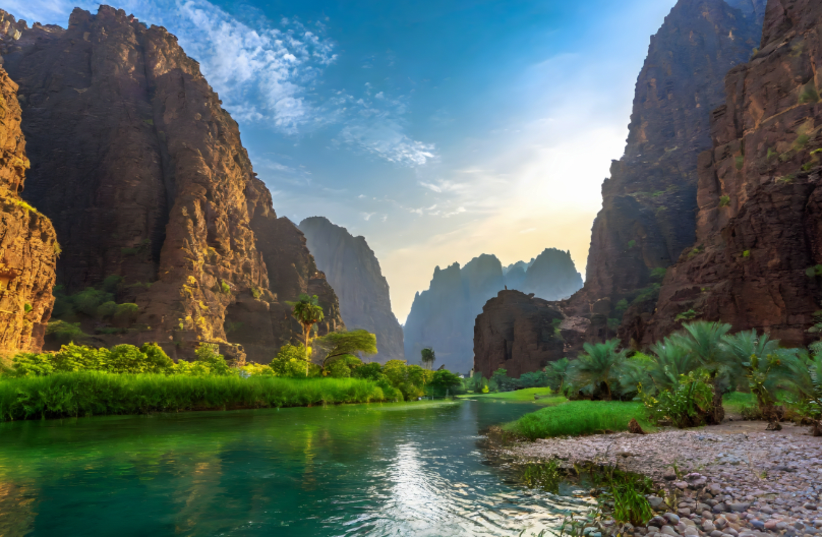By JERUSALEM POST STAFF
Fossil evidence shows existence of elephants, giraffes, and crocodiles thriving in environments rich in rivers and lakes.
Saudi Arabia was once a verdant oasis teeming with rivers, lakes, and abundant wildlife, according to findings unveiled by the Saudi Heritage Authority on Wednesday. The study, published in the journal Nature, reveals that the arid deserts of the Arabian Peninsula were lush and hospitable eight million years ago, characterized by dense vegetation and heavy rainfall.
"The study uncovered 'the longest climatic record in the Arabian Peninsula based on cave deposits, which is also one of the longest climatic records in the world, covering a very long time period of eight million years'," stated Dr. Ajab Al-Otaibi, General Director of the Antiquities Sector at the Saudi Heritage Authority, during a press conference at the authority's headquarters in Riyadh, according to Anadolu Agency.
The research is part of the Green Arabia Project, an initiative aimed at enhancing scientific research and documenting the natural and cultural history of the Arabian Peninsula. Thirty researchers from 27 different local and international entities participated in the study, including the Saudi Heritage Authority, the Saudi Geological Survey, King Saud University, the Max Planck Institute in Germany, and several universities and research centers from countries including Germany, Italy, Britain, and the United States.
The study, titled "Repeated Humidity Periods in the Arabian Peninsula Over Eight Million Years," was based on evidence extracted from cave sediments in extremely dry areas of central Arabia. Researchers analyzed 22 cave formations, known locally as Duhool Al-Samman, located northeast of the Riyadh region near the center of Shawiya in the Ramah Governorate. These caves have become some of the oldest terrestrial records available for the region.
Using precise analysis of chemical deposits in the cave formations, including calcium carbonate deposits, the researchers employed the Uranium-Thorium (U-Th) and Uranium-Lead (U-Pb) dating techniques to accurately determine the age of these formations and reveal the humid periods. They also analyzed oxygen and carbon isotopes to clarify indicators of changes in rainfall and vegetation cover over time.
Dr. Abdullah Al-Sharikh, supervisor of the Green Arabia Project, explained that field studies relied on solid scientific techniques recognized globally. "The Arabian Peninsula, like many geographical areas, has undergone global climate influences throughout history," he said, according to Al Arabiya. "These changes have led to alternating periods of wet and dry or semi-dry climates in the Arabian Peninsula, confirming that wet periods were a recurring phenomenon in the region for millions of years."
The oldest of these humid phases dates back to the late Miocene epoch, about eight million years ago, and continued through the Pliocene epoch and into the late Pleistocene epoch. "Through this analysis, several humid phases characterized by heavy rainfall were identified," Al-Sharikh added.
Fossil evidence showed the existence of animals that lived in the region, including elephants, giraffes, cows, horses, hippopotamuses, and crocodiles. These species thrived in environments rich in rivers and lakes—environments that no longer exist in the current dry context of the desert. The study indicated that intermittent wet conditions facilitated the migration of mammals between Africa and Eurasia, demonstrating the Arabian Peninsula's role as an ecological bridge for the spread of living organisms between Africa, Asia, and Europe.
According to the results, the desert of the Kingdom, which today is one of the largest dry geographical barriers on the face of the earth, "was a natural link for animal and human migrations between the continents of Africa, Asia, and Europe," as reported by Anadolu Agency. This finding supports interpretations about how climatic changes have affected the movement and spread of human groups throughout history.
The Saudi Heritage Authority emphasized that this study represents just the beginning of a deeper understanding of the natural history and environmental richness of the Kingdom. "New studies are forthcoming that will contribute to enriching our knowledge about these topics," the authority stated, according to Al Arabiya.
Both the Saudi Heritage Authority and the Heritage Commission emphasized their commitment to supporting scientific research and expanding the scope of international cooperation in this field. They underscored the importance of sustaining the natural and cultural heritage, which is still under exploration. The caves in Saudi Arabia, they noted, represent an undiscovered scientific treasure waiting to have their secrets uncovered.
The publication of this study in Nature adds international academic weight to the importance of the project. It reflects international cooperation and global interest in the Arabian Peninsula as a corridor between three continents, enhancing Saudi Arabia's position as a scientific reference in climate research and natural history.
"This discovery is a new confirmation that the land of the Kingdom is rich in unique scientific and natural treasures, waiting to be uncovered," Dr. Al-Otaibi said. "It reflects the pioneering role of the Kingdom in enriching global scientific knowledge, especially in the fields of environment, climate, and ancient geology."
The Green Arabia Project began in 2010 and has continued through several research seasons, culminating in this publication. The project aims to uncover the environmental dimensions and climatic changes that have affected the region over the ages, supporting interpretations about how these changes have impacted the movement and spread of human groups throughout history.
"This climatic record is classified as one of the longest climatic records in the world, covering a very long time period of eight million years," the Saudi Heritage Authority stated. "It also serves as scientific evidence of the richness and diversity of the terrains and topography in the Kingdom of Saudi Arabia."
The researchers concluded that the climatic changes revealed by the study have been reflected in the nature of life in the Arabian Peninsula, helping to reveal the rainy periods and their humid fluctuations over millions of years. These findings confirm that wet periods were a recurring phenomenon in the region for millions of years.
"This increase in glacial coverage caused extreme changes in the atmosphere and climate patterns around the world," the study noted. "Climate fluctuations and rainfall led to the contraction of the humidity periods."











.jpeg)





.png)



